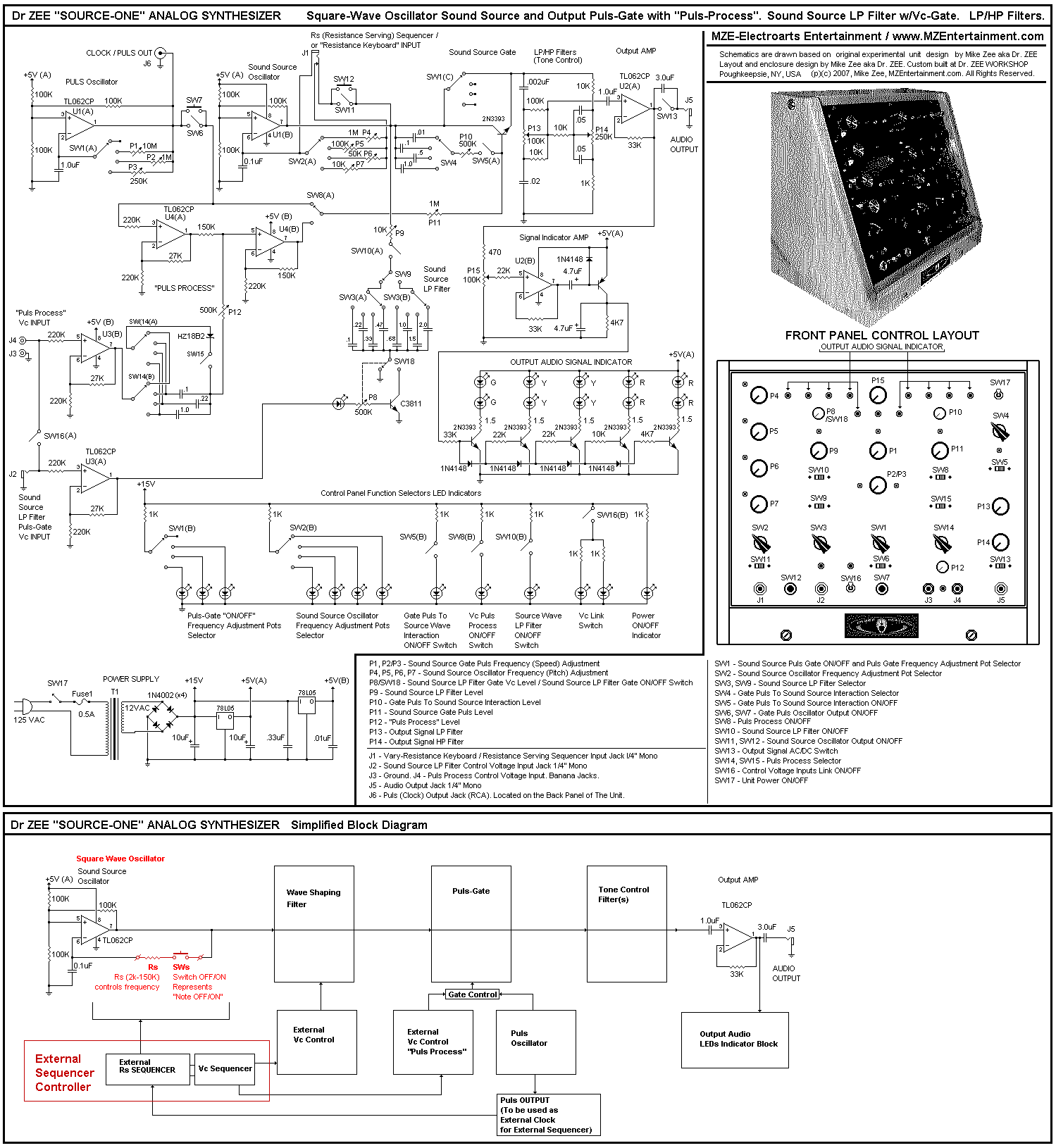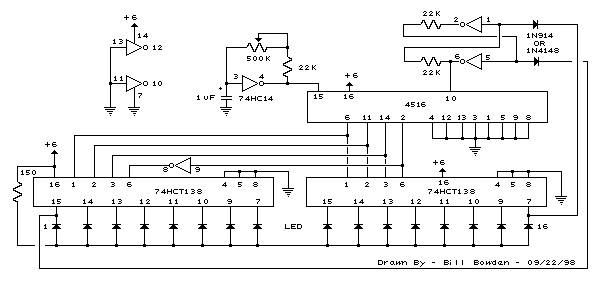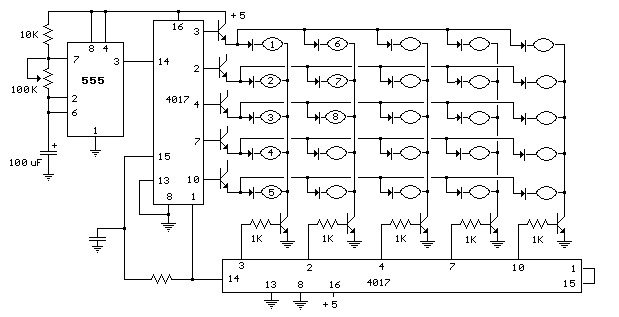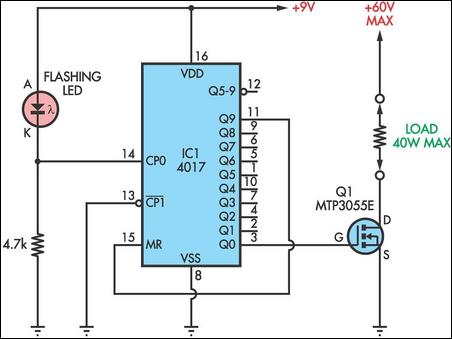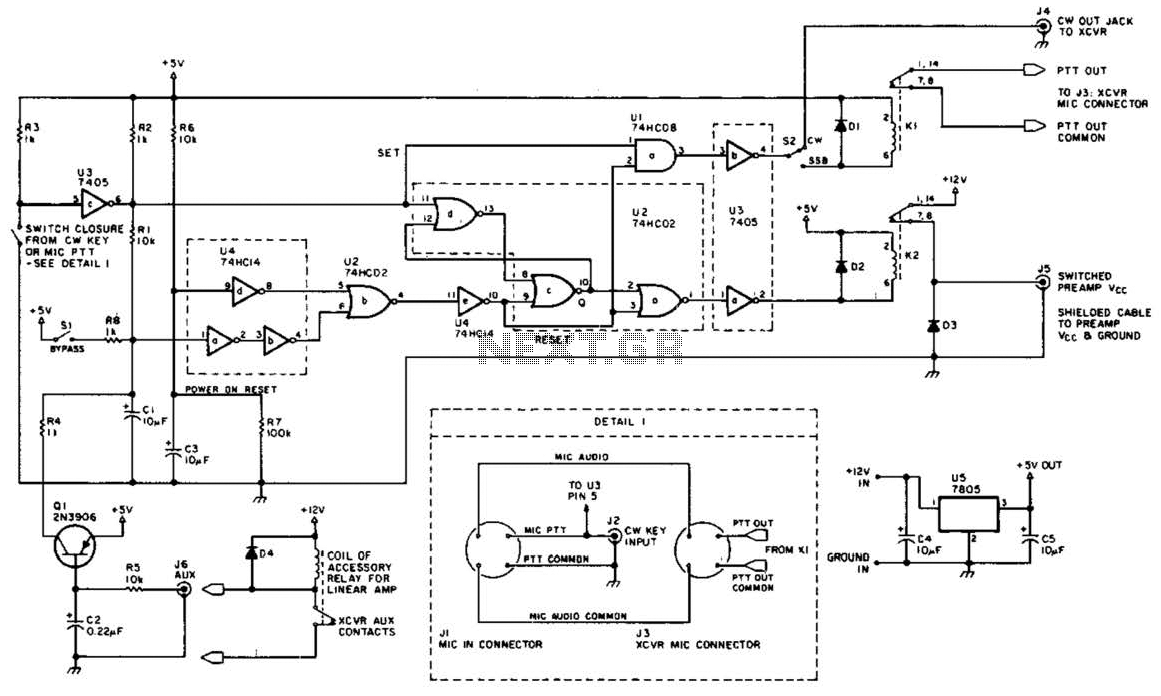
sequencer
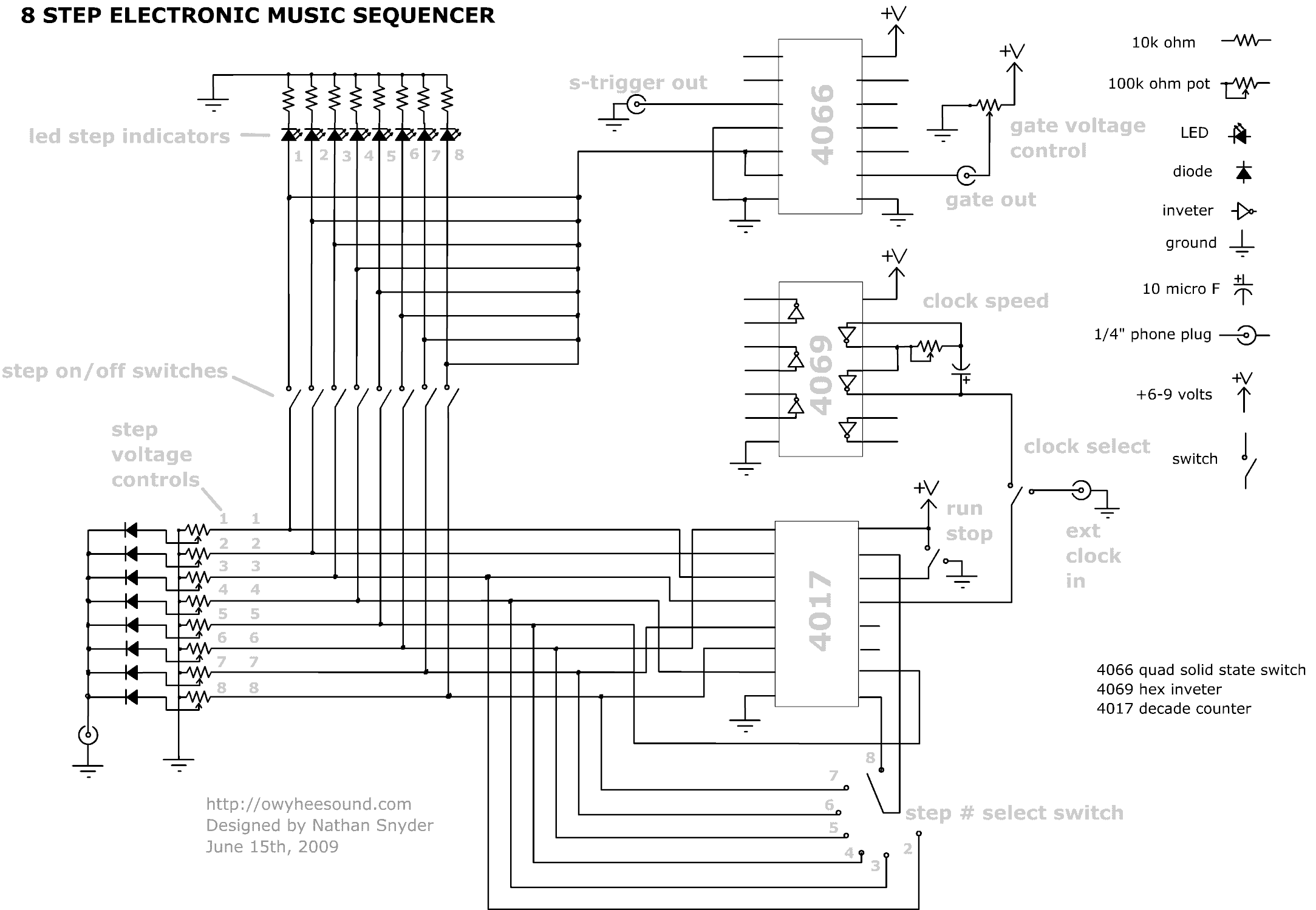
A sequencer used for music is a device that sequences musical events for predictable playback. For early electronic instruments, these sequencers often take the form of a collection of switches that are cued in series and which trigger some other device like a VCA. The switches may also be used to control a variable voltage source that adjusts the pitch of an oscillator. The sequencer typically has a number of switches that is a multiple of 2, such as 4, 8, 12, or 16, and includes a looping function so that the series of switches may restart as soon as the last switch in the series is triggered. The sequencer is primarily designed around the 4017 IC chip. The 4017 is a decade counter that can be reset to start over counting from one at any step. This is achieved by connecting the next sequential step to the reset pin. For instance, to have the sequencer count to five and start over, the step six pin is connected to the reset pin. If the sequencer is to count to step eight and restart, then the step nine pin should be connected to the reset pin. To obtain further details about the 4017 chip, one can search for "4017 data sheet." From the 4017 chip, several features are provided in the schematic, including a voltage output that can control any VCO (voltage-controlled oscillator), like those found on Moog, Dot Com, Paia, Doepfer, and other analog synthesizers. Each step has a potentiometer that can assign a specific voltage for that step, allowing for the easy programming of 8-note melodies or bass riffs. Another feature is the S-Trigger/Gate output option. This sequencer can function as a rhythm generator by utilizing the S-Trigger output, which can control the throughput of any line-level audio signal. By toggling the switches for each step, patterns can be created beyond simple binary oscillations. The gate output is similar but sends a voltage to its output to control other devices, such as VCA (voltage-controlled amplifiers) or even envelope generators on analog synthesizers.
The described music sequencer operates by utilizing a series of switches that trigger musical events in a predictable manner, making it an essential tool in both modern and vintage electronic music production. The design leverages the 4017 decade counter IC, which allows for versatile control over musical sequences. Each switch in the sequencer is connected to a unique output pin on the 4017, enabling the selection of various musical notes or rhythms.
The sequencer's looping function ensures that once the last switch is activated, the sequence restarts, allowing for continuous playback and rhythmic patterns. The implementation of potentiometers at each step provides the capability to adjust the voltage output, which directly influences the pitch of connected oscillators, enabling the creation of melodies or bass lines with precision.
The S-Trigger output option is particularly noteworthy, as it allows the sequencer to interface with other audio equipment, controlling line-level signals for rhythmic modulation. This feature enhances the sequencer's functionality, making it suitable for live performances and studio recordings alike. The gate output further expands the sequencer's capabilities, allowing it to control voltage-controlled amplifiers and envelope generators, thus integrating seamlessly with a variety of analog synthesizers.
Overall, the sequencer described is a powerful and flexible tool for musicians and sound designers, providing an intuitive interface for creating complex musical sequences and rhythms. The combination of the 4017 IC's capabilities and the additional features such as voltage control and trigger outputs makes this sequencer a valuable addition to any electronic music setup.A sequencer used for music is a device that sequences musical events for predictable playback. For early electronic instruments these sequencers often take the form of a collection of switches that are cued in series and which trigger some other device like an VCA. The switches may also be used to control a variable voltage source which controls t he pitch of an oscillator. The sequencer most commonly has a number of switches that is a multiple of 2 like 4, 8, 12, 16, and has a looping function so that the series of switching may restart as soon as the last switch in series is triggered. The sequencer is primarily designed around the 4017 ic chip. The 4017 is a decade counter that can be reset to start over counting from one at any step. This is achieved by connecting the next sequential step to the reset pin. For example if you want the sequencer to count to five and start over the step six pin is connected to the reset pin, and if you want the sequencer to count to step 8 and start over then the step nine pin should be connected to reset pin.
To get further detail about the 4017 chip simply google image search "4017 data sheet" From the 4017 chip several features are provided in the above schematic including a voltage out that can control any VCO (voltage controlled oscillator) like the ones found on Moog, Dot Com, Paia Doepher, and other analog synths. Each step has a potentiometer that may assign a specific voltage for that step. This allows for 8 note melodies or bass riffs to be easily programmed. Another feature is the S-Trigger/Gate output option. This sequencer may be used as a rhythmator type sequencer by using the s-trigger output. The s-trigger can be used to control the through put of any line level audio signal, and by toggling the switches for each step patterns can be created beyond simple binary oscillations.
The gate is similar but sends a voltage to its output to control other devices like VCA (voltage controlled amplifiers) or even envelope generators on analog synthesizers. 🔗 External reference
The described music sequencer operates by utilizing a series of switches that trigger musical events in a predictable manner, making it an essential tool in both modern and vintage electronic music production. The design leverages the 4017 decade counter IC, which allows for versatile control over musical sequences. Each switch in the sequencer is connected to a unique output pin on the 4017, enabling the selection of various musical notes or rhythms.
The sequencer's looping function ensures that once the last switch is activated, the sequence restarts, allowing for continuous playback and rhythmic patterns. The implementation of potentiometers at each step provides the capability to adjust the voltage output, which directly influences the pitch of connected oscillators, enabling the creation of melodies or bass lines with precision.
The S-Trigger output option is particularly noteworthy, as it allows the sequencer to interface with other audio equipment, controlling line-level signals for rhythmic modulation. This feature enhances the sequencer's functionality, making it suitable for live performances and studio recordings alike. The gate output further expands the sequencer's capabilities, allowing it to control voltage-controlled amplifiers and envelope generators, thus integrating seamlessly with a variety of analog synthesizers.
Overall, the sequencer described is a powerful and flexible tool for musicians and sound designers, providing an intuitive interface for creating complex musical sequences and rhythms. The combination of the 4017 IC's capabilities and the additional features such as voltage control and trigger outputs makes this sequencer a valuable addition to any electronic music setup.A sequencer used for music is a device that sequences musical events for predictable playback. For early electronic instruments these sequencers often take the form of a collection of switches that are cued in series and which trigger some other device like an VCA. The switches may also be used to control a variable voltage source which controls t he pitch of an oscillator. The sequencer most commonly has a number of switches that is a multiple of 2 like 4, 8, 12, 16, and has a looping function so that the series of switching may restart as soon as the last switch in series is triggered. The sequencer is primarily designed around the 4017 ic chip. The 4017 is a decade counter that can be reset to start over counting from one at any step. This is achieved by connecting the next sequential step to the reset pin. For example if you want the sequencer to count to five and start over the step six pin is connected to the reset pin, and if you want the sequencer to count to step 8 and start over then the step nine pin should be connected to reset pin.
To get further detail about the 4017 chip simply google image search "4017 data sheet" From the 4017 chip several features are provided in the above schematic including a voltage out that can control any VCO (voltage controlled oscillator) like the ones found on Moog, Dot Com, Paia Doepher, and other analog synths. Each step has a potentiometer that may assign a specific voltage for that step. This allows for 8 note melodies or bass riffs to be easily programmed. Another feature is the S-Trigger/Gate output option. This sequencer may be used as a rhythmator type sequencer by using the s-trigger output. The s-trigger can be used to control the through put of any line level audio signal, and by toggling the switches for each step patterns can be created beyond simple binary oscillations.
The gate is similar but sends a voltage to its output to control other devices like VCA (voltage controlled amplifiers) or even envelope generators on analog synthesizers. 🔗 External reference
